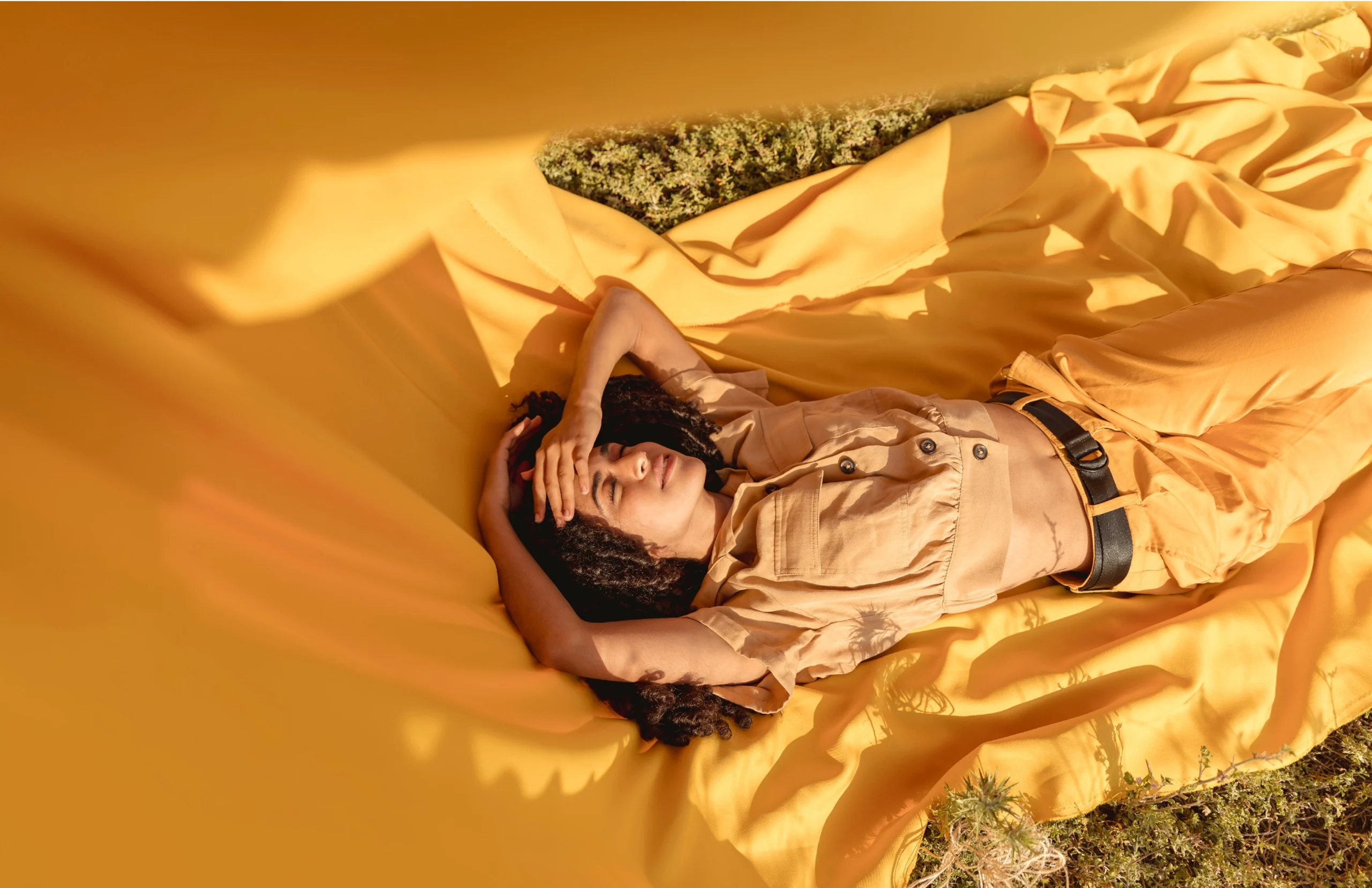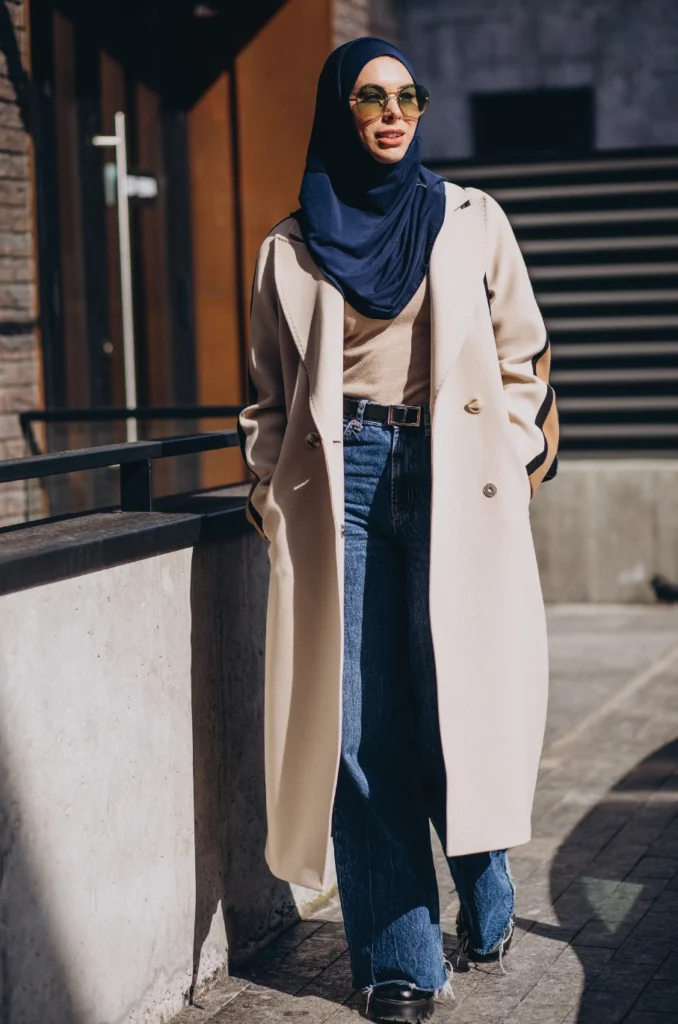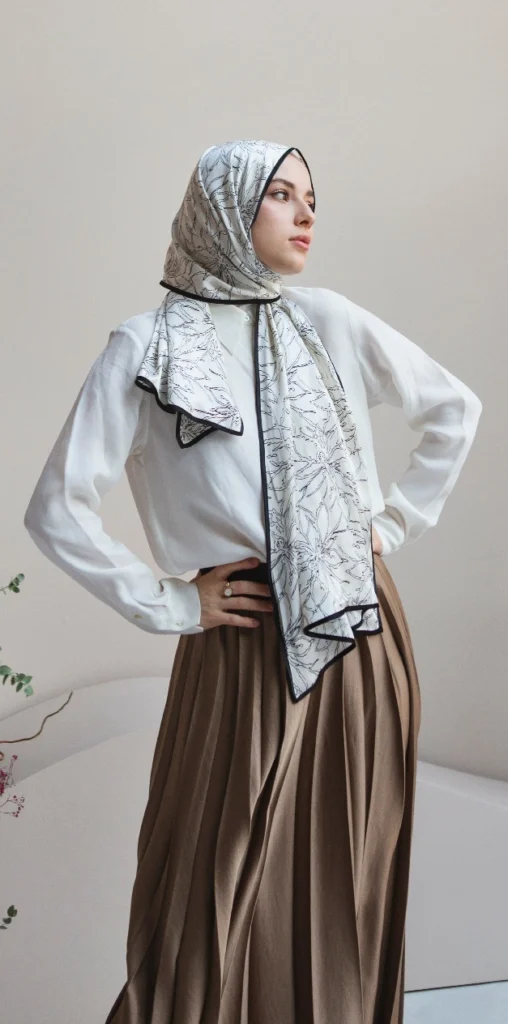THREADS OF CHANGE
Rising Star in Iraqi Media and Entertainment
By Hafsa Qadeer

A few hours before dawn in a Riyadh souk, richly embroidered abayas hang like tapestries against the warm stone walls. The soft glow of lanterns illuminates abaya silhouettes in every hue – deep sapphire, coral pink, olive green. In the Middle East today, these flowing robes are no longer just modest dresses; they are canvases of self-expression. Designers and women alike are weaving heritage with high fashion, turning centuries-old traditions into runway statements. Each paisley print, glittering crystal and cut-out trim tells a story of a society blending the sacred and the stylish. As one Saudi brand calls it, every outfit is “the attitude you wear”.
In this region, fashion and identity swirl together like the silk threads of a kaftan. From Gulf metropolises to mountain villages, men and women are redefining what it means to dress modestly, embracing luxury and leisure alike. In Oman, for example, Ramadan is literally a runway: women “renew their interest in traditional fashion that reflects the authentic Omani identity, infused with touches of modernity”. Delicate Mukhwar dresses – hand-embroidered with gold thread on silk – share space with Moroccan jalabiya kaftans in soft beiges, sky blues and rosy pinks. Omani boutiques fill with sequined caftans and embroidered silk scarves the way markets brim with spices. In the early days of Ramadan, women choose opulent, embroidered traditional gowns for family iftars; by the final ten nights they favor simpler, lighter abayas and jalabiyas for comfort and elegance.
In Beirut and Amman and Abu Dhabi, designers tap centuries of Arab and Islamic art. Jordan’s Basma Abu Ghazaleh of KAGE mixes Bedouin motifs with luxe fabrics – as one report notes, her label “combines sophistication with cultural nuances,” redefining modest wear with a “contemporary edge”. Even in places once isolated from global runways, the new generation is bold. In Doha, the young brand Vandella “masters the art of the T-shirt, jeans, and abaya ensemble,” offering capsulized abaya collections with “impeccably tailored designs”. 1309 Studios in Qatar pairs traditional abayas with sharp blazers and jackets, “redefining abayas for women who aren’t afraid to stand out”. Azalea Designs in Doha brings bright pop colors and classic Arabesque embroidery to flowy modern silhouettes. There are even Qatari perfume houses and home-decor lines like Wadha fusing Islamic geometric patterns with minimalist luxury. Across the Gulf, the message is clear: tradition is the foundation, not the limit.
Gulf Glamour: UAE & Qatar
Dubai and Abu Dhabi have become global fashion hubs. Local labels are turning modest clothing into modern chic. Dubai’s Bouguessa brand, founded by Algerian-born Abdujalil Bouguessa, is known for its “minimalist yet sumptuous approach”. Its refined abayas and tailored dresses blend clean European cuts with subtle Middle Eastern details. Nearby, Emirati designer Hessa Falasi set tongues wagging at Fashion Forward Week with a collection of gorgeous pink abayas tied with surprise bows and neon trim – proof that even the most covered-up look can feel playful. Falasi herself summed it up: “The Middle East designers are changing the market…We love quality, we love to dress up,” she said after her show. “Five years ago, who knew that you would see hot pink abayas and neon colors on an Emirati runway?” she laughed, marveling at how quickly tastes have shifted.


Not far off, a new generation of Gulf brands is sprouting. In Qatar, the House of Malachite offers statement heels alongside satin robes; Hissa Haddad is famous for jeweled silk sandals and frothy lavender gowns fit for a princess. A bridal shop in Kuwait City sells abaya-inspired wedding dresses with gold embroidery. Even Abu Dhabi’s art fairs now feature Islamic-inspired streetwear. Modern and traditional exist side by side: on the same shopping street you might find a high-street dress boutique next to a tailor offering hand-block-printed jalabiyas from India.
Through it all, modesty remains a core value. As designer Hannah Hassan of Saudi’s Nirvana brand observes, wearing the abaya or hijab is “more to do with how we behave and carry ourselves than what we wear”. Her team’s latest collection “celebrates the elegance of rich cultural heritage that defines unity in diversity”. They call it “ethnic traditional art with an outrageous modern attitude” – fine silk brocades and lace that can be a flowing kaftan one day and a stylish beach robe the next. In Saudi Arabia, too, colors are no longer taboo. As Arab News reported, “Saudi girls and women” now wear abayas in “vibrant and daring colors, patterns and fabrics” as a form of self-expression.
In Riyadh boutiques and Jeddah pop-ups, racks of abayas often feel more like art galleries than uniform black closets. One emerging designer, Reem Al-Bayyat of the label Mad Since 1982, literally cuts and pastes together abayas from patchwork fabrics printed with her own drawings. “Every piece tells a story; no two look the same,” she says. Her bright creations make the everyday abaya look like a quilted canvas. Lamya Al-Sarra of Lamya’s Abayas goes even further with bold summer hues. She describes her own gowns as “timeless, elegant, and effortlessly stylish. Each piece is designed to make a statement… I love playing with bold colors, interesting cuts, and unexpected details”. Both women started by designing dresses for friends and quickly found the demand grew. Today, Saudi girls stop strangers on the street to ask about the eye-catching outfits, proving once again that modesty and glamour go hand in hand.
Majestic Oman: A Ramadan Runway
In Oman, the story is as much about celebration as couture. Every Ramadan, Omani women thoughtfully plan a wardrobe that bridges modesty and joy. It might start with a hand-embroidered Mukhwar dress – a long, flowing gown woven from silk and cotton and stitched with gold or silver thread – perfect for the first Iftar gatherings. But as the month progresses, pastel kaftans and light cotton abayas take over, offering ease during the hot desert nights. Markets in Muttrah and Nizwa bustle with shoppers choosing from the latest Ramadan collections. “Women in the Sultanate of Oman are keen to acquire the latest designs for Ramadan outfits as well as prepare for Eid,” says Nadia Al Kharousi, who runs an Omani boutique.
Luxury still plays a role. For special occasions, many Omanis favor the smooth drape of a Moroccan-style jalabiya or the sleek lines of a new abaya design. To accessorize, traditional silver jewelry – engraved rings, stacked bangles and long pearl necklaces – adds ancient Omani flair to any outfit. Even scarves have seen an upgrade: embroidered silk hijabs in Omani patterns now compete with plain cotton. By Ramadan’s end, though, practicality sets in. Maryam Al Hatrooshi, a longtime customer, notes that “in the early days, women often opt for luxurious traditional fashions adorned with hand embroidery; as the last ten days approach, the demand for simple abayas and jalabiyas increases, when many prefer comfort…whilst maintaining elegance”.
Oman is also adopting the global push for sustainability. There is a growing preference for natural fabrics and local craftsmanship. Many women now intentionally “support local products” – choosing cotton and linen made in Oman, hand-embroidered by local artisans. Younger designers in Muscat are reworking vintage Omani shawls and woven belts into modern outfits. The trend toward eco-conscious design even reached a national level: producers are increasingly using organic dyes and traditional khanjars (daggers) motifs in their clothing. In essence, Omani fashion during Ramadan and Eid embodies “a unique blend that reflects the beauty of Omani heritage” while embracing today’s style.
Beirut and Beyond: Creative Resilience>
Beirut’s streets and studios tell a different tale. After years of upheaval and crisis, Lebanese designers are proving that hardship can kindle creativity. At Fashion Trust Arabia in 2024, the focus was on uplifting homegrown talent more than ever. Hussein Bazaza, a Beirut couturier famous for sculptural eveningwear, adapted this year’s collection in real time. He explains that the recent conflict in Lebanon “forces us to channel our emotions into our work, turning struggle into art. This is the core of creativity — transforming adversity into something beautiful,” he says. His team even began using leftover fabric scraps to make blankets for those displaced by the conflict.
Other designers took similar paths. George Azzi and Assaad Osta (Azzi & Osta) had just finished shooting their Spring/Summer 2025 collection in Beirut when the air strikes started. They managed to present it in Paris — pointedly inspired by “the joy of travel” in the face of turmoil. They too agree: “The instability has shaped our creative process… We’re looking forward to more collaborative projects that highlight our culture”. Even jeweler sisters Tania and Dima Nawbar, who run L’Atelier Nawbar, carried on studio routines amid bomb blasts. Their pieces “fuse traditional Lebanese craftsmanship with modern, narrative-driven design,” they say, using techniques passed down through their family alongside edgy storytelling motifs.
Lebanon’s upheaval is unique, but it highlights a wider idea: fashion can be fortitude. Beirut has long been called the creative capital of the Middle East, a city where couture houses (Elie Saab, Zuhair Murad) live beside streetwear pop-ups. Even Syrian refugees and Palestinian Palestinians have established boutiques. In Egypt’s narrow alleys or Riyadh’s malls, locals see the same spirit: global attention to the region’s designers. Fashion Trust Arabia’s co-founder, Tania Fares, put it simply – now more than ever the world is “shining a spotlight on the region, particularly Lebanon,” to support these voices. Homegrown brands from Cairo to Casablanca use fashion as a narrative: a red embroidered patch or a calligraphy print can convey pride in heritage.
Beyond Clothes: Beauty, Wellness, and Attitude
The Middle East’s style renaissance isn’t just about garments; it’s also reshaping beauty and wellness ideals. For decades, many in the region equated beauty with European features – high noses and light skin through surgery or filters. But today, a new wave celebrates authenticity. Vogue Arabia calls this shift a “beauty correction” – not surgical, but cultural. The nose “once exiled” is back, along with natural brows, lashes and curls. Leading Dubai dermatologist Dr. Hussein Yassine observes, “We’re seeing a shift toward authenticity… The goal is no longer to look like someone else. It’s to look like your best self”. He notes clients increasingly favor subtle skin treatments and glowing complexions over overfilled faces. Iconic models of Middle Eastern heritage – like Imaan Hammam (Moroccan-Egyptian) and singer Elyanna (Palestinian-Chilean) – now top fashion campaigns and music charts, proudly wearing their roots on their faces.
Men have quietly joined the trend, too. Once shy about self-care, more Gulf gentlemen now get jawline contouring, laser hair removal, and grooming facials without stigma. Yassine explains that male beauty ideals are “softening,” and treatments are viewed as tools to look “fresh, not frozen”. Gyms and yoga studios also keep popping up in Dubai and Beirut, mixing wellness with the social scene. Brides-to-be might hit the hammam (steam bath) for glowing skin before their big day. Spas offer saffron-laced massages and rosewater facials, combining local ingredients with luxury.
Social media and influencer culture accelerate these changes. The UAE and Saudi have some of the world’s highest smartphone usage – around 99% internet penetration – making the Gulf a trendsetter for the Arab world. Christian Kiefer of Spa Wellness Project Management points out that in the Emirates, “beauty and wellness are essential lifestyle components”, so Instagram stars and YouTubers wield huge power over what people try. Thousands of fans follow Arab makeup artists, nail techs and yogis on TikTok. Brands now partner with micro-influencers to launch cosmetic lines (Arabia’s first halal skincare, for example). At the same time, experts warn of pitfalls: endless selfies and filtered images can raise anxiety. A study quoted in Fast Company found heavy social media use drives body dissatisfaction. The message is changing, though: many influencers now encourage self-love.
Cultural attitudes are also softening about why people dress fashionably. In the Arab News interview with Nirvana’s Hannah Hassan, she asked about critics who say an abaya is only for concealment and should never draw attention. She replied: “Hijab… has more to do with how we behave and carry ourselves than what we wear… Islamic clothing is any outfit that covers our body and adds elegance, respect and grace”. In other words, people recognize modest dress as a choice – one that can express empowerment, not just piety. In living rooms and cafés across the region, young women swap tips on pairing hijabs with lipstick shades or athleisure wear. And many men now see grooming as normal: in some Saudi barbershops you’ll hear talk of the latest whey-protein shakes along with chivalry and couture.
The Future Woven with Identity
The Middle Eastern fashion scene today is a tapestry of old and new. In it, desert landscapes and city skylines overlap on the fabric: flowing caftans here, tailored abayas there; traditional handicrafts next to 3D-printed jewelry. Above all, the common thread is confidence. As designer Hannah Hassan of Nirvana says, an outfit should “define the inner beauty of a person,” rather than hiding it. Middle Eastern men and women are taking that to heart. They wear vibrant abayas, head-turning kaftans, or sleek suits not to fit a mold but to tell their story.
From grand bazaars to urban boulevards, the region’s style is dynamic and personal. A young Emirati woman in Dubai might pair a gold-embroidered abaya with sneakers and call it chic. An Omani grandmother might add a neon shawl to her wedding sari. A young Saudi professional might choose a soft-pastel abaya for office hours and swap it for a sequined one at dinner. Slowly but surely, neighbors and the global stage are tuning in to these choices. As one Emirati journalist put it after a runway show of colorful abayas: in the Middle East “creativity” has no bounds.
Fashion and lifestyle here no longer mimic the West alone, but draw deeply on local roots. The result is a vibrant, diverse panorama: women in Beirut repurpose vintage Lebanese tapestry into clutch bags; men in Qatar slip into slim-cut Islamic robes (thobes) made from Italian silk. Beauty brands sell mukhalat perfumes alongside collagen serums. And behind it all is a spirit of pride and progress. After all, each embroidered pattern, each bold outfit is her story (or his). It’s a reminder that even as the winds of modernity blow, these cultures do not fade – they transform, one elegant thread at a time.
